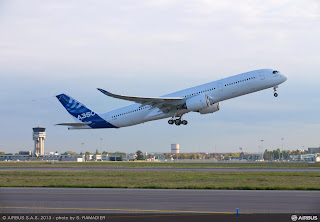In the era where increased incidents and accidents are attributed to flight crew non-adherence to procedures, what can be done to ensure increased SOP compliance?
Saturday, November 16, 2013
Increasing SOP Compliance
Srinivas Rao | 12:27 AM |
A320
|
A330
|
A340
|
A350
|
A380
|
AIRBUS
|
procedures
|
SAFETY
|
SOP
|
STANDARDS
|
TASKS
|
TRAINING


Saturday, November 9, 2013
AIRCRAFT GO-AROUND MANEUVER
Srinivas Rao | 3:11 AM |
A330
|
A350
|
AIRBUS
|
AIRCRAFT
|
crew
|
DECISON MAKING
|
GO AROUND
|
procedures
|
SAFETY
|
TRAINING


One question that is frequently asked in aviation circles about piloting issue is as to why a go-around was not carried out when the approach was unstable.
What is it that makes a well trained and proficient crew shy
away from conducting a go-around on the approach when it is required so??
Labels:
A330,
A350,
AIRBUS,
AIRCRAFT,
crew,
DECISON MAKING,
GO AROUND,
procedures,
SAFETY,
TRAINING
Wednesday, July 25, 2012
ILS Signal Interference

Recently a commercial large jet was cleared for an ILS
approach to Runway 28 at Chicago O’Hare airport. While inbound to intercept the
Glide slope, the cockpit indications were initially full up. Abruptly the
display changed from full up to full down position and the aircraft pitched
down and descended to stay on the glide slope. The pilot reacted to disconnect
the autopilot, but not before the aircraft had descended a 100 ft. The display restored
to full up deflection soon thereafter.
This anomaly
was most likely caused by disruption of the Glide slope signals caused by a
large cargo aircraft holding for take-off. ATC controller had advised the crew
of this aircraft that they were not required to protect the ILS critical area.
Labels:
critcal area,
ILS,
Instrument approaches,
Spurious indications
Wednesday, June 6, 2012
EMAS: Engineered Material Arresting System
 Aircraft overruns during landing and take-off
are a frequent occurrence and statistically are the fourth largest cause of
airline fatalities. . An overrun occurs when an aircraft passes beyond the end
of a runway during an aborted take-off or while landing. To minimize the
hazards of overruns, the Federal Aviation Administration (FAA) incorporated the
concept of a safety area beyond the runway end into airport design
standards. However, there are many
runways, where natural obstacles, local development and other constraints make
the construction of the RESA impracticable. Recognising the difficulty associated
with accomplishing RESA without compromising the performance capability of a
runway, research programmes were initiated to find alternate and effective
arresting solutions.
Aircraft overruns during landing and take-off
are a frequent occurrence and statistically are the fourth largest cause of
airline fatalities. . An overrun occurs when an aircraft passes beyond the end
of a runway during an aborted take-off or while landing. To minimize the
hazards of overruns, the Federal Aviation Administration (FAA) incorporated the
concept of a safety area beyond the runway end into airport design
standards. However, there are many
runways, where natural obstacles, local development and other constraints make
the construction of the RESA impracticable. Recognising the difficulty associated
with accomplishing RESA without compromising the performance capability of a
runway, research programmes were initiated to find alternate and effective
arresting solutions.
Labels:
EMAS,
Overruns,
Reject take Off,
RESA,
RUNWAY EXCURSION
Sunday, May 27, 2012
A380 PUSHING TECHNICAL BOUNDARIES
Srinivas Rao | 11:01 PM |
A380
|
A380 CRACKS
|
AERODYNAMICS
|
AIRBUS
|
COMPOSITES
|
THEORY OF FLIGHT


Airbus has always been at the forefront of pushing technical
boundaries in aviation and excelling in aircraft design and technology. Airbus
says efforts to lower the weight of the world's largest airliner lay behind
recent A380 wing cracks and pledged to learn from mistakes that lay
dormant for a decade, as repair costs looked set to climb towards 500 million
euros ($A642 million).
Labels:
A380,
A380 CRACKS,
AERODYNAMICS,
AIRBUS,
COMPOSITES,
THEORY OF FLIGHT
Subscribe to:
Comments (Atom)




